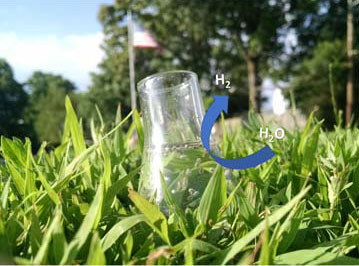
When exposed to sunlight, star-shaped gold nanoparticles coated with a semiconductor allow efficient production of hydrogen from water. [Image: Ashley Pennington / Rutgers University New Brunswick]
Boosting renewable energy and combating climate change are crucial scientific goals, but one common roadblock is how to effectively store solar energy once it’s been harvested. One way around that roadblock is hydrogen. Once liberated from water through photocatalysis (the action of splitting H20 molecules using solar photons), hydrogen can chemically store solar energy—and can then be burned with virtually no pollution in fuel cells when the sun isn’t shining.
Researchers from Rutgers University, USA, have now found a nanotech-driven way to dramatically boost the efficiency of photocatalysis (Chem, doi: 10.1016/j.chempr.2018.06.004). The secret lies in star-shaped gold nanoparticles, coated with the semiconductor titanium dioxide (TiO2). The Rutgers team found that spiking a photocatalytic system with these nanostars can produce hydrogen from water more than four times more efficiently than other methods.
Boosting photocatalysis
TiO2 is a desirable semiconductor for photocatalysis because of its abundance, low cost, stability, and well-aligned valence and conduction bands. But because of its large band gap, TiO2 can use only UV radiation to drive water-splitting reactions. The Rutgers team, led by engineering professor Laura Fabris, wanted to see if there were ways to tap a larger slice of the solar spectrum.
To do so, the team took advantage of plasmonics—the subwavelength concentration of electromagnetic energy that occurs when light strikes the interface between a metal and a dielectric. That energy concentration results in a local surface plasmon resonance (LSPR), with intense local electric fields. Those intense fields, in turn, can enhance the formation of excited or “hot” electrons that can boost photocatalysis rates in the semiconductor.
A (nano)star is born
The researchers’ modeling suggested that the long spikes of star-shaped nanoparticles, which generate intense electric fields at their tips when illuminated with visible and near-infrared (NIR) radiation, were the most promising candidates for plasmonic hot-electron generation under sunlight. The team developed a method for synthesizing such nanostars without a surfactant, which allowed a shell of TiO2 to be grown directly onto the gold surface, facilitating efficient electron transfer between the nanostars and the semiconductor. An added bonus is that, since their shape can be modified to change the number of points and dimensions, nanostars allow for predictable tunability of the LSPR bands from the visible to the NIR.
“Instead of using ultraviolet light, which is the standard practice, we leveraged the energy of visible and infrared light to excite electrons in gold nanoparticles,” team leader Fabris said in a press release. “Excited electrons in the metal can be transferred more efficiently into the semiconductor, which catalyzes the reaction.”
Low-temperature process
The researchers found that a simple, low-temperature, sol-gel approach worked best to synthesize and tune the TiO2-coated nanostars. The low temperature preserves the delicate morphology of the particles. "We were also able to use very low temperature synthesis to coat these gold particles with crystalline titanium, Fabris explained in a press release. “I think both from the materials perspective and the catalysis perspective, this work was very exciting all along.”
The team believes that these results promise to “greatly broaden the ways we take advantage of sunlight,” and could provide nanostructured platforms for better understanding metal–semi-conductor interfaces.
